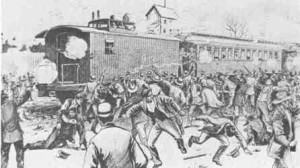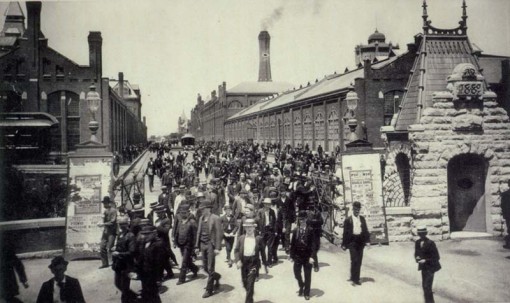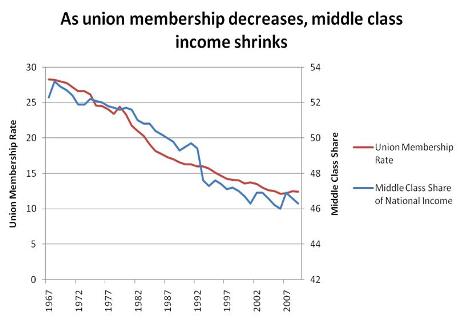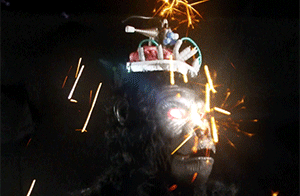I know it’s probably cheating, but here’s something that I wrote a couple of years ago on the occasion of Labor Day. If anything, I think it’s even more appropriate today.
As some of you probably know, Labor Day was first celebrated here in the United States in 1882. It wasn’t, however, made a national holiday until 1894, in the wake of a bloody strike by employees of the Pullman Palace Car Company, an Illinois-based manufacturer of luxury rail cars. It all began when the company, after having cut the wages of workers across the board by as much as 25%, refused to reduce the rent charged to these same workers, who lived and worked in the company town of Pullman, Illinois. And, from there, the strike spread throughout the railroad industry… The following extended clip comes from the Kansas Heritage Group:
…The strike went peacefully, but after several weeks the Pullman management had not changed its position and the strikers were desperate for aid. During the strike, the American Railway Union had convened in Chicago because it was the rail center of the United States. The recently formed American Railway Union had 465 local unions and claimed the memberships of 150,000 workers. Since, the Pullman workers were an affiliated union on strike in Chicago the ARU offered to send arbitrators for the Pullman cause. The Pullman workers refused this aid, even so the ARU under the leadership of Eugene Debs decided to stop handling Pullman cars on June 26 if the Pullman Union would not agree to arbitration. The stage was set for the largest strike in the nation’s history.
On June 26, the ARU switchmen started to refuse to switch trains with Pullman cars. In response, the General Managers Association began to fire the switchmen for not handling the cars. The strike and boycott rapidly expanded, paralyzing the Chicago rail yards and most of the twenty-four rail lines in the city.
On July 2 a federal injunction was issued against the leaders of the ARU. This Omnibus Indictment prevented ARU leaders from “…compelling or inducing by threats, intimidation, persuasion, force or violence, railway employees to refuse or fail to perform duties…” This injunction was based on the Sherman anti-trust act and the Interstate commerce act and was issued by federal judges Peter S. Grosscup and William A. Woods under the direction of, Attorney General, Richard Olney. The injunction prevented the ARU leadership from communicating with their subordinates and chaos began to reign.
Governor Altgeld of Illinois had been hesitant to employ the state militia to put down the strike instead relying on the local authorities to handle the situation. However, he said he would use the National Guard to protect property. Above all Governor Altgeld did not want federal troops to intervene. However, the issuing of this federal injunction and the fact that mail-trains might be delayed caused President Grover Cleveland to send in federal troops from Fort Sheridan. On July 3, Federal troops entered Chicago against Governor Altgeld’s repeated protests. Governor Altgeld protested by writing President Cleveland on July 5, saying, “…surely the facts have not been correctly presented to you in this case, or you would not have taken the step, for it seems to me, unjustifiable. Waiving all questions of courtesy I will say that the State of Illinois is not only able to take care of itself, but it stands ready to furnish the Federal Government any assistance it may need else where…” Despite these repeated protests by Governor Altgeld, President Cleveland continued to send in federal troops.
The reaction of the strikers to the appearance of the troops was that of outrage. What had been a basically peaceful strike turned into complete mayhem. The mayhem began on July 4, with mobs of people setting off fireworks and tipping over rail cars. The workers started to tip railcars and build blockades in reaction to the presence of the federal troops. In addition to this, there was additional level of chaos caused by the ARU leaders’ inability to communicate with the strikers because of the federal indictments. The rioting grew and spread then on July 7, a large fire consumed seven buildings at the World’s Colombian Exposition in Jackson Park. This burning and rioting came to a zenith on July 6, when fires caused by some 6,000 rioters destroyed 700 railcars and caused $340,000 of damages in the South Chicago Panhandle yards.
At this time in the Chicago vicinity, there were 6,000 federal and state troops, 3,100 police, and 5,000 deputy marshals. However, all this manpower could not prevent the violence from peaking when on July 7, national guardsmen after being assaulted, fired into the crowd killing at least four (possibly up to thirty) and wounding at least twenty. The killing continued when two more people were killed by troops in Spring Valley, Illinois. All this violence started to cause the strike to ebb and on that same day Eugene Debs and four other ARU leaders were arrested for violating the indictment. These officers were later realized on $10,000 bond. The strike was failing rapidly, so the ARU tried to enlist the aid of the AFL in the form of sympathetic strikes. When this was refused the ARU attempted to abandon the strike, on the grounds that workers would be rehired without prejudice except were convicted of crimes however, this offer was refused by the General Managers’ Association. The strike continued to dwindle, and trains began to move with increased frequency. The strike became untenable for the workers and on August 2 the Pullman works reopened.
This strike was truly monumental if some of the figures for lost revenues are looked at. The railroads alone lost an estimated $685,308 in expenses incurred during the strike. However, the railroads lost even more in revenue an estimated $4,672,916. In addition, 100,000 striking employees lost wages of an estimated $1,389,143. These costs are just the localized effects of the paralyzation of the nation’s rail center and do not include the far ranging financial effects. The manpower used to break the strike was also immense. The total forces of the strikebreakers both government and private were: 1,936 federal troops, 4,000 national guardsmen, about 5,000 extra deputy marshals, 250 extra deputy sheriffs, and the 3,000 policemen in Chicago for a total of 14,186 strikebreakers. In addition to these figures there were also twelve people shot and killed, and 71 people who were arrested and sentenced on the federal indictment. This strike had other far ranging consequences. The federal government took an unprecedented step in using indictments to make any form of a strike essentially illegal and supported this action by deploying federal troops against the will of the states.
The results of the Pullman Strike were both enormous and inconsequential. They were enormous because the strike showed the power of unified national unions. At the same time the strike showed the willingness of the federal government to intervene and support the capitalists against unified labor. The results were inconsequential because for all of the unified effort of the unions the workers did not get their rents lowered.
 So, several men in Chicago lost their lives, labor had been struck a tremendous blow, and President Grover Cleveland, fearing an even greater worker revolt, pushed the national holiday through Congress in order to appease the masses. And, now, we celebrate the day by grilling out and taking one last dip in the pool.
So, several men in Chicago lost their lives, labor had been struck a tremendous blow, and President Grover Cleveland, fearing an even greater worker revolt, pushed the national holiday through Congress in order to appease the masses. And, now, we celebrate the day by grilling out and taking one last dip in the pool.
Here’s to all the men and women who died so that we might enjoy the 40 hour work week, safe working conditions, and all the rest of it… Let’s enjoy the fruits of their labor while we can, because God knows we’ll see kids working in coal mines again in our lifetimes. To do otherwise, after all, would be Socialism.
update: A link to the following graph was just left in the comments section. I thought that it deserved to be up here, where it had a greater likelihood of catching your attention.














5 Comments
This incident took place during a period in American history that featured dramatically rising income inequality – including obscene wealth being accumulated by 1% (the “Robber Barons”) … and falling wages, and deteriorating working conditions and job security for remaining 99% (“everybody else”).
Hmmm …
I am so appreciative of the people who risked so much to make things better for everyone. I also feel that the work is not over and that the 40 hour week is too long for many people and too short for others. I actually would like to see the FLSA replaced with a Guaranteed Minimum Income but, alas, I don’t expect to see that in my lifetime.
I wonder how much the general public realizes that when they fly on almost all US airlines, they are placing their trust (and lives) in the hands of a unionized flight deck crew. And its not all about wages and work rules. As a retired 30 year airline pilot I am very proud of the immense work my union (Air Line Pilots Association) has done, and continues to do, to improve airline safety, often with airline managements kicking and screaming “It will cost too much”, or having to deal with the immense bureaucracy of the FAA. I firmly believe that airline safety would be nothing like it is now without unions.
I was just down in Columbus, Ohio, this weekend and read an article in the Columbus Dispatch about the last unionized coal mine in Kentucky had recently closed… Just in time for Labor Day…
Why do you hate children? Why do you hate freedom? No one forced children to work in coal mines. They chose to do so. That is called freedom, and we need more of it today. Stop forcing children into government schools. Allow them to breath the sweet air of freedom through a hose at the bottom of a coal mine.